
Exhibitions: Current | Upcoming | Past
Exhibitions: Past
Connections
Milisa Galazzi Toby Sisson Kristin Street
September 6 – October 11, 2018
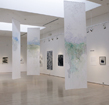
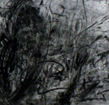
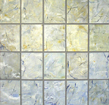
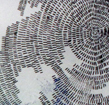
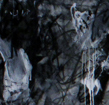
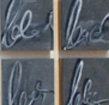
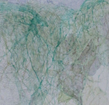
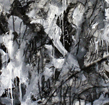
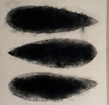
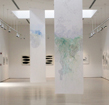
The way humans engage with stories is time-based. There is usually a beginning, middle, and an end. We expect that because that is also how we perceive moving through time. We experience the present moment, but it is evaluated or tempered by our awareness of linear time. Our memories of the past and our anticipation of the future inform our relationships to the current moment. From our experiences, we develop strategies of analysis but sometimes we are perplexed when outcomes do not match our expectations.
Throughout our evolution, we have created a variety of complex belief systems that utilize conceptual thinking. And we often use symbols to convey some of these notions; rather than writing about them, sometimes we draw about them. Making a drawing requires a series of actions that align across a two-dimensional surface and often, push into a two-dimensional surface. The results can create an ambiguous sense of space and time. The familiar vocabulary of
mark and shape, a record of an action and thought, creates illusions of boundaries. The picture plane is both a lens into a world and the world itself.
The artists in the exhibition CONNECTIONS use drawing and mark making to examine the human condition. Each artist's use of the language of drawing is time-based. Their works are physical, meticulous, searching, symbolic, and a meditation on ways to manipulate materials to convey something essential about our relationships to each other. Ideas about the mark as image, the mark as writing, the mark as defining a shape or space, and the mark for its own sake percolate throughout the works on display.
Milisa Galazzi, Toby Sisson, and Kristin Street met each other through the artist's group, 19 on Paper. They also have a shared history of working in encaustic, a wax process for creating images. Their ongoing dialogue with each other about their work has been important and is integral to this project on display in the gallery. Their works are generated independently, but informed by conversations and studio visits with each other and collective observations and mutual sensibilities.
Kathleen Hancock
Director
Artists
Milisa Galazzi
My work is about human connections and the subtle yet powerful ways in which we interact with one another. Our strength as human beings lies in paying attention to the smallest details—noticing what we think, feel, do, and say to one another. Being aware of and responding to the details around us is what makes life as a human being more, rather than less, interesting, worthwhile, and ultimately fulfilling. A life well lived is created by thoughtful, intentional, considered and decisions coupled with instinctual spontaneity and immediate reactions.
The way in which we speak to one another, the way we share a glance, a look, a response to a comment, and even our body language—are all ways that we let another person know that we hear them, we appreciate them, we are connected to them. When we become fully present for one another—when we put down our technology when another person walks into the room, when we look into the other person's eyes when we speak gently and thoughtfully, when we really listen to what the other person is saying and not simply just hear them, then we are truly connecting as human beings. The tone and tenor of our human interactions matter. How and what we say and do in the presence of another person is the stuff of real, human, connection.
As the pace of life speeds up with the ever increasing processing speed of technology, slowing down and moving at a human pace—not a digital pace—is ever more challenging, yet so important to me as an artist. When I am in the studio, I practice being present. The marks I make on paper are a direct recording of this process of self connection. The asemic lines in my drawings have no 'semic content'—they literally say nothing—however the marks are richly imbued with immense feeling. In this way, my work speaks to being in the moment and experiencing universal feelings of connection.
Toby Sisson
My artwork examines the breadth of metaphoric meaning that can be derived from non-objective abstraction, especially psychological and social content. Through mixed media paintings, drawings and prints, I make paradoxical concepts tangible with formal elements, such as the repeated use of the color black, which acts as both presence and absence, simultaneously weighted and ephemeral.
I value the associative power of abstract images for their capacity to suggest complex ideas with basic shapes and colors. Black's strong correlation with solemnity, mystery, and race is an evocative visual tool. A spot of darkness can radically influence a field of white, yet at the same time, be utterly isolated from it. The contrast of opposites attracts and repels. I see obvious parallels in the way people interact across cultural difference, which in turn drives the graphic nature ofmy compositions.
While avoiding overtly didactic messages, my work remains rooted in personal narrative through a connection to my mixed race heritage. A sense of otherness and hybridity is persistent, and that combination marks the materials as well as the content I explore. Working with a variety of substances—charcoal, graphite, beeswax, oil, and ink on paper or wood—asymmetrical relationships of surface, scale, and tone have veiled yet potent connotations. As author and social critic James Baldwin wrote, "The artistic image is not intended to represent the thing itself, but, rather, the reality of the force the thing contains."
Kristin Street
Surface and Space
The relationship between mark making, surface, space, and scale has long been of interest to me. This most recent series explores how those different components can be observed and manipulated to create illusion and a sense of spatial awareness. The repetitive nature of marks within each drawing generates an almost meditative state through the process of making, while the line between the real and imagined is easily blurred.
These compositions grow, line by line, through an additive, spontaneous process into fictional spaces that vacillate between micro and macro scales, dark and light, surface and depth. Within these drawings vellum defines the space. The eye moves between the back of the work and the drawing on the front, moving through the vellum, which is empty of any gesture but creates subtle shifts within the surface plane. This type of drawing, where one thing shifts into another, inherently creates voids. Utilizing both sides of the substrate, marks layer upon themselves to create paths, building toward a larger vision that blends the real and illusionary or imagined world. Through the use of light and shadow, depth of field, and other optical deviations, the positive and negative spaces become indeterminate. The resulting work challenges the relationship between what is imagined on the surface and what is actually rendered—creating a unique experience for each viewer; the map is different for everyone.
As these works have developed over time, there has been a definite shift from looking at the spatial environment toward reflecting on the relationship of surface to space, part to whole. By observing and manipulating surfaces in order to explore line within a physical environment, the marks within each drawing strive towards the experience of space in its most subtle form. Even if they are "only" lines on paper, every mark depicts a front and back and divides light and dark, figure and ground, space and its negation, further developing the illusion between the two surfaces. Drawing the shape of space through topographic explorations, mark making takes on a renewed vigor, guiding the viewer to delve into the compositions and connect with not just the surface, but the richer dialog happening through the layers and between each piece within the series, as well as throughout the collective body of work.
Biographies
Milisa Galazzi
Education
1996 MA, Rhode Island School of Design, Providence, RI
1988 BA, Brown University, Providence, RI
Selected Solo and Group Exhibitions
2018 Organic to Geometric II, Provincetown Art Association and Museum, Provincetown, MA
2017 Black Tie (optional), Invitational, Adam Peck Gallery, Provincetown, MA
2017 Alternative Wax: Layers of Facts, Provincetown, MA
2017 Beyond Rainbow, Gallery Galleon, Vieques, Puerto Rico
2016 Ties That Bind: A Solo Exhibition of Recent Work, Gallery Artrio, Hyannis, MA
Toby Sisson
Education
2009 MFA, University of Minnesota, Minneapolis, MN
2003 BFA, Magna Cum Laude, College of Visual Arts, St. Paul, MN
Selected Solo and Group Exhibitions
2017 The Soul of All Color, E.M. Bannister Gallery, Rhode Island College, Providence, RI
2017 Depth Perception, Cape Cod Museum of Art, Dennis, MA
2017 The Space Between Shadow and Light, Gallery X, Truro Center for the Arts, Truro, MA
2015 ...and other poems, Yellow Peril Gallery, Providence, RI
2014 Then & Now, Mildred I. Washington Art Gallery, SUNY Dutchess Community College, Poughkeepsie, NY
Kristin Street
Education
2005 MFA, Maryland Institute College of Art
1980 BFA, Rhode Island School of Design
Selected Solo and Group Exhibitions
2017 Members Juried Exhibit, Jamestown Arts Center, Jamestown, RI
2017 Guest Artist, Imago Gallery, Warren, RI
2017 National Women's Exhibition, URI Gallery, Providence, RI
2017 NAM Members Juried Exhibition, Newport Art Museum, Newport, RI
2016 Mark, Print, Paint, Fitchburg Museum, Fitchburg, MA

